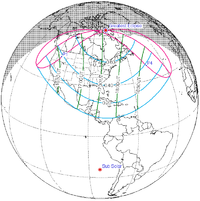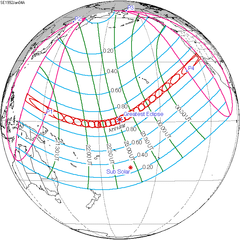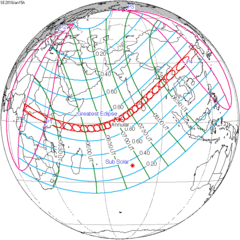January 2001 lunar eclipse
| Total eclipse | |||||||||||||||||
 Totality as viewed from Oria, Italy. | |||||||||||||||||
| Date | January 9, 2001 | ||||||||||||||||
|---|---|---|---|---|---|---|---|---|---|---|---|---|---|---|---|---|---|
| Gamma | 0.3720 | ||||||||||||||||
| Magnitude | 1.1902 | ||||||||||||||||
| Saros cycle | 134 (26 of 73) | ||||||||||||||||
| Totality | 61 minutes, 2 seconds | ||||||||||||||||
| Partiality | 196 minutes, 19 seconds | ||||||||||||||||
| Penumbral | 311 minutes, 2 seconds | ||||||||||||||||
| |||||||||||||||||
A total lunar eclipse occurred at the Moon’s ascending node of orbit on Tuesday, January 9, 2001,[1] with an umbral magnitude of 1.1902. A lunar eclipse occurs when the Moon moves into the Earth's shadow, causing the Moon to be darkened. A total lunar eclipse occurs when the Moon's near side entirely passes into the Earth's umbral shadow. Unlike a solar eclipse, which can only be viewed from a relatively small area of the world, a lunar eclipse may be viewed from anywhere on the night side of Earth. A total lunar eclipse can last up to nearly two hours, while a total solar eclipse lasts only a few minutes at any given place, because the Moon's shadow is smaller. Occurring only about 8 hours before perigee (on January 10, 2001, at 4:00 UTC), the Moon's apparent diameter was larger.[2]
Visibility
The eclipse was completely visible over Africa, Europe, and Asia, seen rising over eastern and northern North America and eastern South America and setting over Australia and the western Pacific Ocean.[3]

|
 Hourly motion shown right to left |
 The Moon passed straight through the center of the Earth's shadow at the descending node in Gemini. | |
Eclipse details
Shown below is a table displaying details about this particular solar eclipse. It describes various parameters pertaining to this eclipse.[4]
| Parameter | Value |
|---|---|
| Penumbral Magnitude | 2.16314 |
| Umbral Magnitude | 1.19022 |
| Gamma | 0.37198 |
| Sun Right Ascension | 19h25m03.5s |
| Sun Declination | -21°59'58.3" |
| Sun Semi-Diameter | 16'15.9" |
| Sun Equatorial Horizontal Parallax | 08.9" |
| Moon Right Ascension | 07h25m08.0s |
| Moon Declination | +22°22'46.0" |
| Moon Semi-Diameter | 16'43.0" |
| Moon Equatorial Horizontal Parallax | 1°01'21.1" |
| ΔT | 64.1 s |
Eclipse season
This eclipse is part of an eclipse season, a period, roughly every six months, when eclipses occur. Only two (or occasionally three) eclipse seasons occur each year, and each season lasts about 35 days and repeats just short of six months (173 days) later; thus two full eclipse seasons always occur each year. Either two or three eclipses happen each eclipse season. In the sequence below, each eclipse is separated by a fortnight.
| December 25 Descending node (new moon) |
January 9 Ascending node (full moon) |
|---|---|
 |

|
| Partial solar eclipse Solar Saros 122 |
Total lunar eclipse Lunar Saros 134 |
Related eclipses
Eclipses in 2001
- A total lunar eclipse on January 9.
- A total solar eclipse on June 21.
- A partial lunar eclipse on July 5.
- An annular solar eclipse on December 14.
- A penumbral lunar eclipse on December 30.
Metonic
- Preceded by: Lunar eclipse of March 24, 1997
- Followed by: Lunar eclipse of October 28, 2004
Tzolkinex
- Preceded by: Lunar eclipse of November 29, 1993
- Followed by: Lunar eclipse of February 21, 2008
Half-Saros
- Preceded by: Solar eclipse of January 4, 1992
- Followed by: Solar eclipse of January 15, 2010
Tritos
- Preceded by: Lunar eclipse of February 9, 1990
- Followed by: Lunar eclipse of December 10, 2011
Lunar Saros 134
- Preceded by: Lunar eclipse of December 30, 1982
- Followed by: Lunar eclipse of January 21, 2019
Inex
- Preceded by: Lunar eclipse of January 30, 1972
- Followed by: Lunar eclipse of December 20, 2029
Triad
- Preceded by: Lunar eclipse of March 12, 1914
- Followed by: Lunar eclipse of November 10, 2087
Lunar eclipses of 1998–2002
This eclipse is a member of a semester series. An eclipse in a semester series of lunar eclipses repeats approximately every 177 days and 4 hours (a semester) at alternating nodes of the Moon's orbit.[5]
The penumbral lunar eclipses on March 13, 1998 and September 6, 1998 occur in the previous lunar year eclipse set, and the penumbral lunar eclipses on May 26, 2002 and November 20, 2002 occur in the next lunar year eclipse set.
| Lunar eclipse series sets from 1998 to 2002 | ||||||||
|---|---|---|---|---|---|---|---|---|
| Descending node | Ascending node | |||||||
| Saros | Date Viewing |
Type Chart |
Gamma | Saros | Date Viewing |
Type Chart |
Gamma | |
| 109 | 1998 Aug 08
|
Penumbral
|
1.4876 | 114 | 1999 Jan 31
|
Penumbral
|
−1.0190 | |
| 119 | 1999 Jul 28
|
Partial
|
0.7863 | 124
|
2000 Jan 21
|
Total
|
−0.2957 | |
| 129 | 2000 Jul 16
|
Total
|
0.0302 | 134
|
2001 Jan 09
|
Total
|
0.3720 | |
| 139 | 2001 Jul 05
|
Partial
|
−0.7287 | 144 | 2001 Dec 30
|
Penumbral
|
1.0732 | |
| 149 | 2002 Jun 24
|
Penumbral
|
−1.4440 | |||||
Half-Saros cycle
A lunar eclipse will be preceded and followed by solar eclipses by 9 years and 5.5 days (a half saros).[6] This lunar eclipse is related to two annular solar eclipses of Solar Saros 141.
| January 4, 1992 | January 15, 2010 |
|---|---|

|

|
See also
References
- ^ "January 9–10, 2001 Total Lunar Eclipse (Blood Moon)". timeanddate. Retrieved 12 November 2024.
- ^ "Moon Distances for London, United Kingdom, England". timeanddate. Retrieved 12 November 2024.
- ^ "Total Lunar Eclipse of 2001 Jan 09" (PDF). NASA. Retrieved 12 November 2024.
- ^ "Total Lunar Eclipse of 2001 Jan 09". EclipseWise.com. Retrieved 12 November 2024.
- ^ van Gent, R.H. "Solar- and Lunar-Eclipse Predictions from Antiquity to the Present". A Catalogue of Eclipse Cycles. Utrecht University. Retrieved 6 October 2018.
- ^ Mathematical Astronomy Morsels, Jean Meeus, p.110, Chapter 18, The half-saros
External links
- Saros cycle 134
- 2001 Jan 09 chart: Eclipse Predictions by Fred Espenak, NASA/GSFC
- Jan. 9, 2001 Lunar Eclipse Gallery
- NASA Astronomy Picture of the Day: Total lunar eclipse (18 January 2001)
- NASA 2001 Jan 09: Total Lunar Eclipse
- Total Lunar Eclipses seen from Cape Town[permanent dead link] Total lunar eclipse, January 9, 2001.



